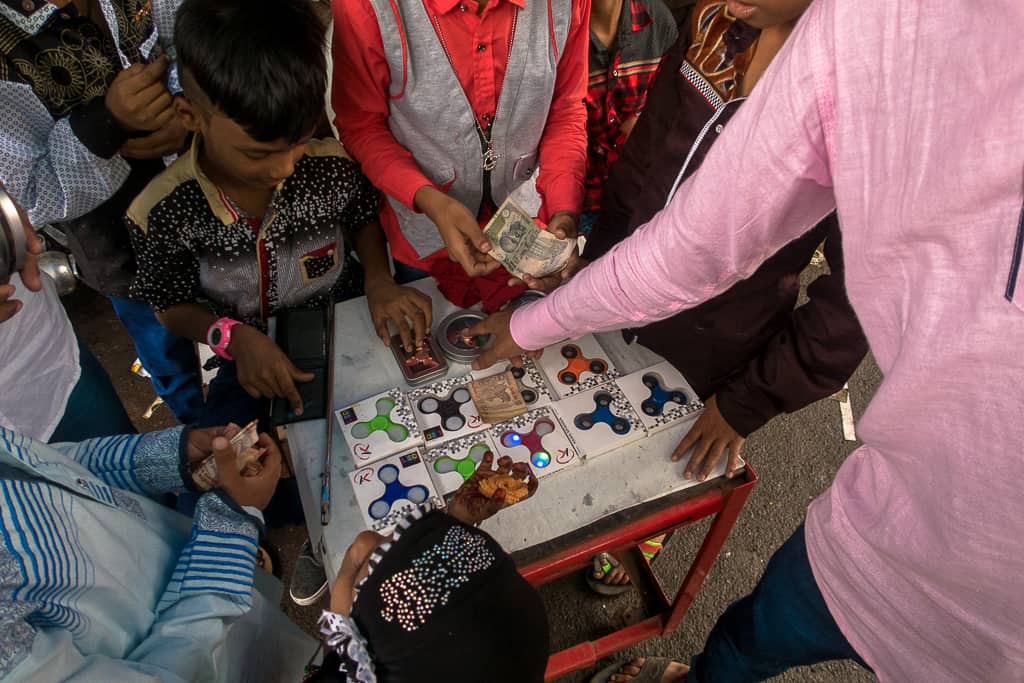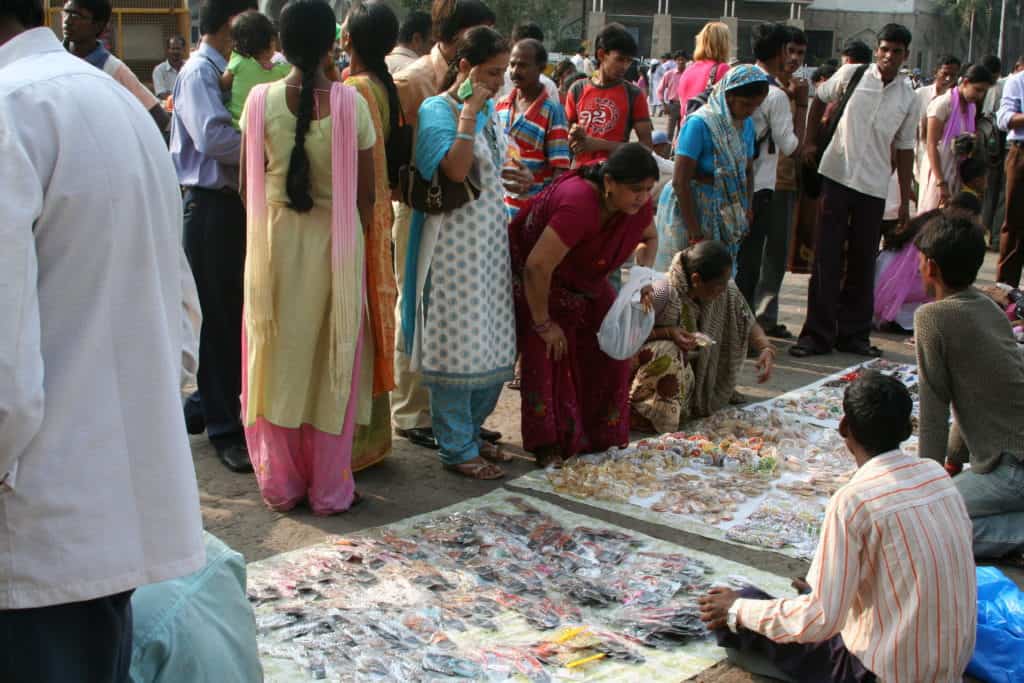Sagir Qureshi, a hawker in Mumbai, has been selling clothes on Hill Road in Bandra for over 50 years. He does not have a shop, instead, he wheels in an assortment of t-shirts and tops on metal racks to his usual spot everyday. In a line on the footpath in front of the brick and mortar shops, he joins the other hawkers getting ready for the evening crowds.
“Mai apne pitaji ke time se yaha hu. Elco Market 1965 me shuru hua tha, tab itne hawkers aur dukaan nahi the. (I’ve been here since my father’s time. The Elco Market started in 1965, and at that time, there weren’t many stores or hawkers),” he says.
It is because of the low prices and the atmosphere of bargaining that hawkers in Mumbai offer, that Hill Road is famed for its street shopping all over the city. With their handcarts, stalls and handheld distribution of clothes and accessories, they add a variety for shoppers to choose from, and a culture the city is much celebrated for. Voices calling “Jeans, ma’am?” punctuate daily strolls down the road.
But, amid the chaos of this daily routine, there is one word all vendors are accustomed to hearing as a warning sign to pause for the day: “Gaadi.”
Meaning vehicle, “gaadi” is code for the arrival of the Brihanmumbai Municipal Corporation’s (BMC) anti-encroachment jeep. Word travels through the grapevine in shouts, echoes and signals from one end to the other. In an almost choreographed manner, the hawkers wind up. Transactions are cut short and shoppers swept aside. Those with their goods in a pile on the road pick and tie the four corners of the cloth base they carry them in. Those with goods on wheels, like Sagir, take off with a rack in each hand. Within minutes, the hawkers disperse into one of the many small lanes that open onto Hill Road, and wait for the gaadi to pass.
This frenzy happens two to three times a day and is fraught with consequences. Eviction carries a huge price for these informal workers, who make a living on lower margins, with no job security or employment benefits. If caught by the BMC, Sagir claims he would have to pay a fine of Rs 1,500 or more to get his goods back.
“Ye sab chalta rehta hai. Agar public complaint jaisa kuch hota hai to bohot zyada strict ho jate hai, to kabhi dheel bhi de dete hai. Hum kya kar sakte hai? (This keeps going on. If there’s a public complaint or something similar, they get very strict. But at other times they give us some leeway. What can we do?),” he says.

An ancient tug-of-war
In 1985, a Supreme Court judgement described this state of affairs as a “tug-of-war” or “a game of hide-and-seek between the Corporation and the hawkers.” The Bombay Hawkers’ Union (BHU) had taken the BMC to court, in response to the civic body’s violent eviction drives and refusal to grant licences. The colonial 1888 BMC Act, which established the corporation, gave it the right to remove any encroachments in a public space without any notice. They argued this was against their fundamental right to “carry on any trade or business,” as granted by Article 19 of the Constitution.
The Court’s decision tread a middle ground. It maintained that public streets were meant for the general public, keeping evictions legal. But it also upheld the constitutional right to hawk, as long as it was within municipal norms.
This was the first in a series of court cases that pit the livelihoods of hawkers against the rights of pedestrians on the street. It was the beginning of the push towards the regulation of street vending. It recommended a scheme adapted on a letter by the municipal commissioner in 1983, demarcating hawking and non-hawking zones. A daily fee of Rs 3 for men and Rs 1 for women would act as a licence fee in permitted places, which excluded the 100 m periphery from hospitals, religious and educational places and 150 m from markets.
Implementation, however, was slow to follow. But the rules would stay, taking on a greater role in the future.
Read more: Why government schemes aren’t reaching those who need it most in Mumbai
The demand for regularisation
Several cases across the country followed, amping up the demand for regularisation. In his book on street food vendors in Mumbai, The Slow Boil, author Jonathan Shapiro Anjaria outlines how hostile citizen and resident groups began vocally opposing hawkers in the 1990s and approached the courts.
The courts began to take a stricter stance, calling for more restrictive controls on hawking. The first steps to codify the regulations came in 2004, with the National Policy on Urban Street Vendors. A decade later, the central government passed the Street Vendors (Protection of Livelihood and Regulation of Street Vending) Act in 2014.
The Act is a comprehensive treatise on the rights and regulation of street vendors, outlining a street vending scheme and protecting hawkers from evictions till it is put into place. It orders local governments to first survey existing hawkers, give them vending certificates (in lieu of licences) and identity cards and accommodate them in vending zones, particularly in areas where markets already exist.
The details, the survey, eligibility conditions, vending fee, conditions for vending zones, etc, were left to the state governments. The Maharashtra government notified the rules in 2016 and the scheme in 2017. The on-ground tasks of surveying and identifying hawkers and vending zones would then be carried out by local Town Vending Committees (TVC).
These 20 member committees would consist of municipal commissioners, the police, hawkers (a majority at 40%), and representatives from NGOs, RWAs and trade associations. Mumbai, due to its large area, would have 7 zonal TVCs alongside the central TVC. All the members would be selected based on applications, but the street vendor representatives would be elected by street vendors.
But Mumbai ran into a problem here. A TVC was needed to conduct an initial survey of hawkers, so they could then elect their representatives. In the absence of one, they needed a temporary fix.
Provisional TVCs were then formed in 2017, in which the street vendors were selected by a lottery. Post the survey, the hawkers would elect and replace them with the elected representatives. The elections, however, have not been held yet and the temporary TVCs still remain.

Where are the licences?
The survey was held in 2014, asking details of caste, religion, sub-caste, nationality, etc, from the hawkers. But only 1.25 lakh forms were distributed among the hawkers estimated to be 2.5 lakh in 2004. The provision of certificates in the Act too is for 2.5% of the population, amounting to well over 2.5 lakh. 99,435 of the filled forms were sent to the BMC.
In limbo till 2018, the hawkers were then asked to send domicile certificates, proving residency in the state for at least 15 years. Not a requirement in the Act, this was brought in as a directive from the Shiv Sena’s party chief, Raj Thackeray.
The lengthy process resulted in the elimination of most hawkers from the list. By 2019, the BMC finally uploaded the ward-wise lists of eligible hawkers, condensed to 18,000, on their website. 89,000 hawking pitches were demarcated, and then finalised to 31,264. Sagir made it through, but neither he, nor others like him, have received their vending certificates.
“All the zonal town vending committees completed their tasks before COVID-19,” says Nayana Kathpalia, who represents the civil society organisation Nagar (previously Citispace) in the TVC of Zone 1. “We physically went to see the spaces marked as hawking pitches, and ensured they followed the guidelines. The main TVC, headed by the Municipal Commissioner, has to decide when to start implementing the scheme now,” she added.
But the fact that this entire exercise has been carried out by the provisional TVCs could mean it is all in vain.
“Government selected TVCs ko vending certificates aur zone dene ka power hi nahi hai. Agar denge to illegal hoga. [These government-selected (unelected) TVCs do not have the power to give hawkers vending certificates or vending zones. Even if they do, it will be illegal],” says Mecanzy Dabre, deputy secretary of the National Hawkers Federation (NHF).
The licence department of the BMC did not respond to calls asking why vending certificates have not been given out yet.

Current status
The impasse on implementation has only grown since the pandemic. Over five years have passed since the hawkers’ survey, rendering it obsolete. It is time for a fresh one, according to the Act. The TVCs have recommended the current list of eligible hawkers in Mumbai be given the certificates, says Nayana, and the next survey done for the addition of different hawkers.
The Maharashtra government’s notification of a revised scheme is also pending. The Bombay High Court rejected the previous one after the National Hawkers Federation (NHF) challenged the domicile certificate requirement in 2017. It is in the final stages, says Mecanzy, and will be passed soon.
Corporators in the BMC have also demanded to be a part of the TVCs, a provision absent from the Act. They were waiting for a reply from the Urban Development Department of Maharashtra, when the current term of the electors came to an end on March 7th.
Meanwhile, evictions continue. “We take action against the hawkers in non-hawking zones, and if we receive complaints or find that they’re causing traffic. But we cannot take strict action against eligible hawkers to whom we’ve not given a vending certificate,” says Harshad Kale, deputy municipal commissioner and member of the TVC in Zone 2. “The Assistant Commissioner of the wards and Senior Inspector for the removal of encroachments confiscate the goods being sold and shift it to a godown, which the hawker can get back by paying a redemption fee,” he adds.
Calling it “manmani”, or high-handedness, Mecanzy believes the BMC and other officials use the absence of legitimate TVCs to continue their precarious hold over the hawkers. “The BMC, police, local authorities aur state government nahi chahte ki street vendors elect ho aur unko power mile, kyuki phir wo sabse questions pooch sakte hai. (The BMC, police, local authorities and the state government do not want to give the street vendors any power, because then they can ask questions),” he says.